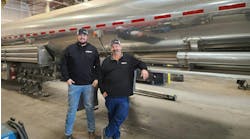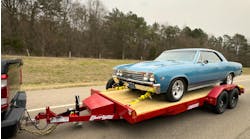Spring show season is winding down, so what have we learned in terms what’s new and what’s coming?
First, a confession: At this point in the calendar, all of the presentations and products start to run together for me, especially on a publication schedule that has us building this issue featuring last month’s events (The Work Truck Show, ATA Technology & Maintenance Council) just as I’m getting back from, or heading to, the events we’ll be covering soon (Mid-America Trucking Show, Truck Trailer Manufacturers Association).
But even in the fog of a worn-out editor’s mind, a few trends emerge. First, the competition is fierce—and that’s fun, at least for an editor attracted by what’s shiny and new.
The really good news: In a prolonged positive market swing, most companies have the capital and the willingness to invest in developing new products and processes. For transportation equipment, that means a continued push into electrification, automation, connectivity and new materials.
Now, these are trends that have been developing for some time, but the speed with which last decade’s drawing board concepts are hitting the highways is the top takeaway from this year’s early round of exhibitions.
I’ve written plenty about electrification and automation in this space and, frankly, after some of the high-tech, high-profile demos that kicked off the year at the Consumer Electronics Show, it’s been a pleasure to play around with recognizable and road-ready equipment that, nonetheless, represents the transition to the next generation of vehicles.
But electrification and automation, while increasingly available for commercial equipment today, are still niche solutions at best. They’re concepts in search of customers, and customers demand a return on investment—and even the biggest boosters tell us that the ROI just isn’t quite there. Yet.
New materials, such as composites for trailers, are now ready for prime time, however. And early adopters might just get a pricing break for taking a chance on a product that still needs a little seasoning, or so I’ve heard in some show floor chats. Likewise, new, lighter materials will play a big role in the viability of electric vehicles. If as a manufacturer you’re not already seriously investigating alternative materials and production processes, tick tock.
Finally, there’s connectivity. From the production floor to products, if you haven’t invested in connected solutions you’re behind the curve. In essence, connectivity is all about operational data, instantaneous analysis and reaction. Putting aside the benefits, operationally, to manufacturers, if you build or sell commercial vehicles your customers now expect telematics solutions both to improve their operations and because their customers—especially those in the supply chain—demand that real-time remote visibility.
Great Dane President Dean Engelage summed it precisely at Heavy Duty Aftermarket Week in January: “Creating a smarter trailer, to connect with an even smarter truck, is the wave of the future.”
Of course, based on products highlighted this spring, that wave has broken. See this month’s coverage from TMC for just a few examples. But speaking of TMC coverage, I’m holding out a panel discussion on smart trailers so that I can give it the complete coverage it deserves later. But here’s a teaser from moderator Paul Menig, a transportation industry veteran and a technology specialist, who called the panel “one of the more important sessions” of this year’s TMC.
“Smart trailer technology is beginning to redefine the capability of trailers,” Menig said. “It’s going to be more than just a box in which goods are hauled. Smart trailers are becoming mobile treasure troves of data containing information on many different aspects of the freight logistics process and the trailer itself.”
Wabash Van GM Mark Ehrlich, who provided the panel’s OEM perspective, said trailer manufacturers must make the transition from being experts in “mechanical innovation” and assembly, to becoming providers of integrated solutions.
“When we look at tomorrow’s specs, or smart specs, they start to sound different; they look different—different considerations, and different expertise,” Ehrlich said. “My engineer that does the wheel-end assembly is not going to be doing my smart trailer integration. That doesn’t carry over. So that is a perspective we’ve got to gear up for. This is a massive amount of change. And we always want to be in the forefront of moving the industry toward better productivity and efficiency—we don’t want to be in the way of that.”
More to come.









